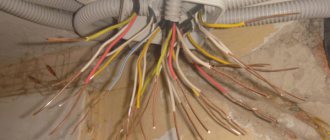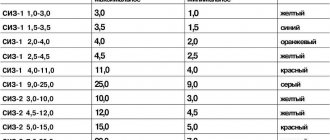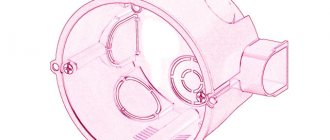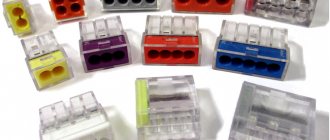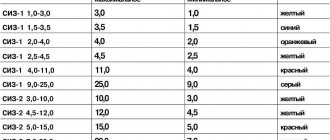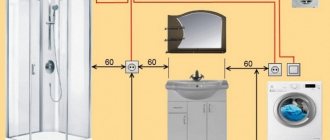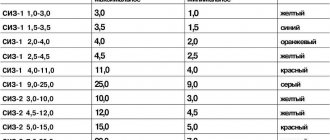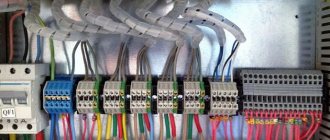Junction box problem
This device not only helps to distribute electrical wires throughout the rooms, but also creates an aesthetic appearance in the place where the twists are made.
Also:
- Provides fire safety;
- They retain their appearance for a long time because they are not subject to mechanical stress;
- Reducing costs for the number of wires and consumables.
If there was no distribution box, then each line would have to be run separately. This device can be external or built into a wall recess.
The box helps to separate connected assemblies from flammable surfaces and is easy to install and use during repairs. You can always add an extra branch if necessary.
Types of distribution boxes
Specialized stores offer customers protective shields, which can be grouped according to individual properties:
- Material of manufacture (PVC, polystyrene, metal);
- They come in round, rectangular or square shapes;
- Degree of housing protection: sealed, with or without protection;
- The input can be different: for cable, corrugation or pipes;
- Closed with a lid with screws and contact installation;
- For different types of installation: hidden or open lines, built into drywall.
Three groups of boxes:
- The desoldering device is intended for tapping and distributing electrical wires in apartments and houses. For example, when installing a switch.
- A distribution box with a terminal block is used when connecting nodes.
The installation mounting box is a socket box; it is used for hidden installation of dimmers, switches and sockets.
Box materials
Plastic
Of the entire range of materials used for the production of these products, plastic of various groups is most often used.
This technical solution is related to:
- With excellent dielectric properties of plastics.
- With low cost of production.
- With the ability to produce various shapes and sizes of products.
- Easily complete plastic products with various additional elements - rubber seals; mounting strips, ease of installation of fixing screws.
- With the long service life of such products, due to the absence of natural destruction of the material.
Metal
At the same time, when installing electrical wiring in warehouses, hangars, workshops, when not only rigid fastening of electrical wires is required, but also exposure to adverse factors in production premises, there is a need to install distribution boxes with higher performance characteristics.
In this case, the best case material would be metal. Metal boxes are made mainly by stamping from sheet metal, followed by priming and painting. Fixation of the cover is achieved using a screw connection. The tightness of the structure is increased with the help of rubber seals at the electrical cable entry points and a rubber seal on the lid.
Installation of distribution box
In a living room, the junction box is installed 15-30 cm below the ceiling. The place must be accessible for regularly checking the condition of the twists.
The device is attached to the wall in several steps:
- According to the instructions, the bottom of the box is screwed to the wall;
- Bring all the ends of the wires inside and connect them together according to the diagram;
- Check the result of the work;
- Close the lid.
Installation of distribution boxes is carried out using self-tapping screws. If the box must stand in a niche, then it is glued with plaster.
Installation instructions
We already know that installation work can be carried out both openly and hidden. Let's consider the existing main stages of each method separately.
Let us remind you! The most reliable way to connect wires to each other is soldering or special clamps, like car terminals.
Open installation
This method is a simple method that does not take much time. Here are step-by-step instructions that will allow you to install a distribution box in the wall yourself:
- At the first stage, you should turn off the electricity in the house and, for safety, make sure that there is no electricity using an indicator screwdriver. We previously covered how to properly use an indicator screwdriver;
- The attachment points of this product should be marked with a simple pencil;
- The box is attached to the concrete wall using dowels. The design usually provides several special holes for self-tapping screws;
- To enter all groups of wires, it is necessary to cut off the tips of the seals. The cuts are made of a smaller diameter compared to the cable cross-section to better protect the wiring from dust and moisture;
- Connect the wires together. To avoid mistakes, we recommend that you familiarize yourself with the color coding of the wires. All that is required of you is to correctly connect phase to phase, then zero to zero, and then ground to ground (this applies to the socket group). Then you need to connect the introductory group of wires with a group of switches and interior lighting;
- After all work, close the box lid.
As you can see, the process of installing a junction box in concrete is quite simple.
Hidden installation
Although it is much more difficult to install the box in a hidden way, as a rule, novice electricians can cope with this work.
So, let's begin:
- We make special grooves in the concrete wall intended for planting boxes. Perform this work with a drill equipped with a special crown attachment. When performing this work, please pay attention that the diameter of the groove fully corresponds to the dimensions of the product. It happens that the landing space is small. In such cases, it will be necessary to level the contours, and if it turns out to be too large, more solution will have to be applied;
- A line should be drawn to the connection point of the box. The installation height from the ceiling should be 10..20 cm;
- It is necessary to make a solution from alabaster and place it in the groove, but before doing this, moisten it a little with water. You can also use gypsum mortar to seal the grooves;
- We install the box flush on the wall and hold it for a while until the solution sets. After all this, all that remains is to remove the remaining residues with an alabaster spatula;
- Connect the wires together;
- The protective cover closes;
- Cover the installation location with wallpaper or apply a thin layer of finishing plaster to the box lid. If after the work done it is not possible to disguise the cover well, then the wallpaper is cut along the contour and the plastic cover on the light-colored wallpaper will no longer stand out.
Helpful advice never hurts! When you connect the wires to each other, be sure to label each group. This applies to the wires of a socket, switch, chandelier, etc. In case of repair work, you can quickly find the necessary wire.
This completes the work and technology for correct installation of the box with hidden wiring in concrete. With this option, installation time will take a little more, but the appearance of the room will not be spoiled.
Installation and connection diagrams
Diagram for normal home wiring
Wiring example for a private house Visual diagram with electrical network elements Wiring diagram through a junction box
Connecting wires inside the box
The electrical line is installed according to a pre-designed scheme. All loads and cross-sections of elements are calculated at the planning stage, and the practical part is carried out as follows:
- Remove 2 centimeters of insulation from all ends of the wires;
- If the cable has a double layer of protection, remove the top layer by 5 cm;
- The wiring is connected by color, it is easy and simple;
- Each twist is crimped with pliers, then wrapped with electrical tape or a plastic cap is put on;
- You can connect the wires in the junction box with the terminals using a clamp, when a twist of the same color is clamped onto one plate.
Then all connections are checked, carefully distributed and the box is closed with a lid.
Installation Methods for Electrical Junction Boxes for Concealed Wiring
A mounting box for hidden wiring is a container equipped with side holes and designed for connecting electrical wires.
This device allows you to provide all appliances in the apartment with electricity. Installing it yourself is not too difficult if you know the installation features.
Design, varieties based on materials of manufacture
The device body can be round or rectangular . The cover is attached with screws. Some distribution devices have gaskets that additionally protect against moisture and dust, as well as seals that allow you to connect reinforced, corrugated or smooth pipes.
Such boxes are made of metal and plastic . The latter are used when laying cables with PVC insulation or using wiring enclosed in plastic pipes. If the wiring is hidden in metal pipes or cables are armored with steel strips, it is better to choose metal boxes.
The photo shows samples of metal and plastic distribution boxes for hidden wiring:
Such devices are made from materials that can provide effective protection of the wiring for the entire period of its operation. High quality plastic and metal are used for the production of cases. The materials are additionally protected with anti-corrosion paints and primers .
Metal products are made from tinned steel sheets. In the event of a fire, such a housing will protect the wiring for some time. You can have time to turn off the power supply.
The plastic body is no less effective. Polypropylene and cast fluoroplastic are not afraid of active substances and provide good protection against electric shock . In a humid environment, such devices can last longer than metal ones. Of course, they are inferior in strength to metal, but at home, boxes are very rarely subjected to significant loads.
Application
The main purpose of using such devices is to ensure fire safety . It is in the places where the wires are connected that fires most often occur. If the contact is not too tight, a large resistance is formed in the connection, which leads to heating of the wire and sometimes to a fire.
Using metal boxes, you won’t have to worry about the fire safety of your home. Even if you have many household appliances installed in your home, a fire will not occur. Installation
When mounting the device, you need to provide access to it . The aesthetics of the room should not suffer either. But the first requirement is still much more important. To make the structure almost invisible, you need to trim the lid with a material similar in color to the wall. If you plan to hide the box under a suspended ceiling, provide a small hatch.
Into concrete
Installation in concrete is quite possible. First you will need to make a groove to fit the product in the wall. The diameter of the groove must correspond to the diameter of the box :
- connect the line to the connection point;
- prepare an alabaster solution, place it in a groove lightly moistened with water;
- Place the box flush with the wall, press so that the solution sets well, clean off the remaining alabaster mixture with a spatula;
- connect the wires together;
- place a protective cover;
- Cover the installation site with wallpaper or apply a layer of finishing plaster to the lid, making it invisible.
Method of installing an installation box in a concrete wall for hidden wiring:
into a brick wall
Installing the device into a brick wall is similar to installing it into concrete. It is done like this:
- Turn off the electrical power in the apartment.
- Choose a place to install the box - as a rule, it is placed at a distance of 15-20 cm from the ceiling level .
- Plan and mark out the system through which electrical cables will be supplied and discharged. They should only go horizontally or vertically . You need to arrange a network of gates for sockets, lighting fixtures and switches. To do this, it is permissible to use the gaps between the floor slabs.
- Route the cables and secure them by labeling the ends to avoid tangling later.
- Use a drill or hammer drill to knock out a seat for the device in the wall, and bring the wires inside. To do this, you will need a hole of the required depth and suitable diameter. Remove the plugs from it and pass the cables through the holes. Make sure that the box fits easily into the niche prepared for it and does not protrude from it.
Insert the body, level it, then seal the cracks with alabaster, gypsum plaster or building plaster, and remove excess mortar with a spatula. Hold the structure a little with your hands so that the mixture has time to set.
into wood
Under no circumstances should distribution boxes be hidden in walls made of wood . They can only be installed outside, choosing places that are accessible for inspection and regular maintenance. Only metal products can be used in a wooden house.
Connecting the branch box
The wiring diagram is determined by the installation diagram, which is developed before the start of work . A neutral, phase wire and grounding must be installed in each box. The devices are connected to wires that go to switches and sockets.
Since the box allows you to connect different groups of wires, keep in mind that they must belong to the same network , type of voltage and the same type of current.
Radio, telephone and fiber optic lines cannot be connected together in one design.
When one of the lines in a mixed distribution box is disconnected, at least one active circuit will certainly remain under current voltage, which is very dangerous. Therefore, if you plan to install different lines, you must provide a separate distribution box .
When entering cables into the box, their outer shell is cut so that at least a small part of it goes inside - 0.5-1 cm. To prevent the cable from slipping out, it is carefully secured at the entrance and exit, as well as along the entire route every 60 or 80 cm . The length of the gaps depends on its rigidity.
Wire connection methods
Wires in a distribution or junction box for hidden wiring can be connected in the following ways:
- using terminal blocks is the most preferred method: such blocks are small and easily fit into the case; you only need to cut the wires, connect the wires and put the resulting assembly inside;
- soldering method - it is suitable for specialists, since a person without experience will spend a lot of time on soldering, and besides, he may not get a really high-quality connection;
- crimping method - provides a reliable permanent connection, but this method is labor-intensive, it requires aluminum or copper sleeves and heat-shrinkable tubing. In addition, you will need press pliers. The stripped wires will need to be inserted all the way into the sleeves at both ends, and then carefully crimped.
Before crimping, you need to put a heat shrink tube on one of the wires. When the crimping is completed, the tube will need to be moved onto the sleeve and heated so that it shrinks and ensures reliable fastening.
Find out in this video how you can connect wires:
Many people use the twisting method the old fashioned way. Indeed, it is very simple, but it is not advisable to use it . It cannot provide a reliable connection of wires, so it can only be used as a temporary measure.
It is prohibited to use this method without complete modification of the connection.
Another useful video about ways to connect wires in a junction box for hidden wiring:
Where you can't use splitters
It is worth knowing that electrical distribution boxes for hidden wiring are prohibited from being installed:
- near open sources of water;
- next to water risers;
- under sinks;
- near sources of temporary and permanent heat - radiators, stoves, air conditioners with heating function, etc.
As you can see, there is nothing complicated in installing a junction box for hidden wiring. Any apartment owner will be able to cope with such work. You just need to remember the safety rules and install only when there is no electricity in the network .
Source
Precautionary measures
When installing the distribution box, it is important to follow safety precautions. If the wires contain different metals, they are connected with adapters. You cannot twist different materials directly.
Be sure to find out where the ground, phase and neutral are located. Before installing the cover, you need to check the functionality of the line.
To do this, connect a powerful household appliance to the network and check the twist: does it heat up or not. If suddenly some wire becomes warm, it means that the contacts need to be better fastened, or replaced with wires with a larger cross-section.
Description of popular models
The most popular product on the market is considered to be the distribution box from Tuso.
It has the following distinctive characteristics:
- Running size: height 4 cm and diameter 6 cm;
- Used indoors for branching wiring;
- The round body with a lid is made of non-flammable plastic;
- The cover is secured with latches;
- Can be installed in concrete and brick;
- It is attached to an open place with screws;
- Has 4 inputs sealed with rubber bands;
- Has good protection against moisture.
This is a budget option, the device is cheap.
Best Junction Boxes with Terminal Blocks
The main feature of such models is ease of installation. To connect a wire to such a box, just strip one end, insert it into the contact group and tighten the fastening screw.
IEK KM41206
4.9
★★★★★
editorial assessment
97%
buyers recommend this product
The model is made of high-strength plastic. It is not afraid of sharp impacts and scratches, does not support the combustion process, which guarantees additional safety during operation of the box.
The dimensions of the device are 50x50x20 millimeters, weight - 19 grams. The box is securely fixed using one fastener, which ensures convenience and high speed of installation anywhere.
Advantages:
- durable body material;
- fire resistance;
- quick installation;
- light weight and compactness;
- durability.
Flaws:
- Difficulty removing the cover.
IEK KM41206 is suitable for insulating outlet points for lighting cables and power networks with voltages up to 1000 V. An excellent choice for work under heavy loads.
Hegel KRK2702 0201-I
4.9
★★★★★
editorial assessment
94%
buyers recommend this product
Installation of the Hegel box is carried out using nails and dowels, without taking much time. The screw terminal blocks installed inside the box have 5 pairs of clamps for fixing conductors with a cross-section from 1.5 to 6 mm². If necessary, they are easily removed.
The device dimensions are 75x75x30 millimeters and weighs 400 grams. The base is made of polypropylene, the cover is made of impact-resistant polystyrene. It is not afraid of heavy mechanical loads and can withstand temperatures up to +650 °C.
Advantages:
- quick installation;
- easy removal of terminal blocks;
- heat resistance;
- high strength.
Flaws:
- a little heavy.
Hegel KRK2702 0201-I is used in premises for various purposes, where operating conditions are quite difficult.
EPP 240343
4.8
★★★★★
editorial assessment
89%
buyers recommend this product
The design of this model includes sealing glands that ensure reliable fixation of cables and reduce the likelihood of moisture and dust getting inside the unit. Number of inputs - 4.
The dimensions of the box are 75x45 millimeters. The lid is locked using a special latch, which makes it easier to access the internal elements if necessary. The box meets a high protection class and can be used at temperatures from -45 to +45 °C.
Advantages:
- excellent heat resistance;
- high protection class - IP54;
- compactness;
- presence of seals;
- quick removal of the cover.
Flaws:
- flimsy body.
The EPP 240343 terminal box is recommended for installation in any, even unheated rooms and in open areas under a canopy.
TDM Electric SQ1401-0906
4.7
★★★★★
editorial assessment
85%
buyers recommend this product
The model has a modern design and meets increased safety requirements. The protection class of the box is IP40. The inside of the cover has special notches for more convenient formation of cutouts to fit the cable size.
The dimensions of the block are 75x75x28 millimeters. Fastening is carried out using a standard self-tapping screw and takes only a few minutes. The main manufacturing material is impact-resistant polystyrene.
Advantages:
- high strength;
- quick installation and reliable fixation;
- small dimensions;
- increased safety of use.
Flaws:
- afraid of humidity.
TDM Electric SQ1401-0906 is designed to hide and additionally protect the cable under conditions of sudden temperature changes.
Junction box Legrand Atlantic IK10
The box is large in size and quadrangular in shape, and also has its own characteristics:
- Height 8 cm, area 15x15 sq. cm;
- Intended for indoor use;
- Made of metal;
- The cover is attached to the body with screws;
- Mounted on brick and concrete surfaces;
- You can mount the housing to the wall or use brackets;
- Paired with the box are mounting perforated slats;
- There is moisture protection;
- The top and outside of the box is varnished and painted.
The only negative is the high cost of the device.
Which one is better to choose for your home?
First, the type of wiring is determined: open or hidden. Then a junction box is selected to make it easier to enter the wiring into the housing.
The degree of protection from moisture and dust is also important. Inside the house, an IP44 rating is suitable as it is designed for dry areas. Here you can choose an inexpensive but reliable option.
The box is also selected according to configuration. If the wall is made of concrete, then it is better to take one with a smooth surface, and if it is made of plasterboard, it will be suitable for fastening with screws.
How many holes are needed and what size in the box is calculated based on the size of the electrical cable that will be pulled.
The installation box must be installed on the internal electrical line. The installation is not difficult, but it will help to avoid many troubles. The main thing is to choose the right option so that it includes all the twists and knots. You can do this work yourself using diagrams and instructions.
Best Outdoor Junction Boxes
Such boxes are fixed on the surface of the wall, ceiling or other structural elements. They do not require lengthy preparation of the base, are installed using standard fasteners and are easy to maintain.
Ecoplast JBS150 (44009)
5
★★★★★
editorial assessment
100%
buyers recommend this product
The model is made of ABS plastic, is shock-resistant and is relatively inexpensive. The holes for the introduction of pipes and cables are closed with glands, which eliminates the risk of contamination and gives the box a more aesthetic appearance.
Number of outputs - 10, dimensions 150x110x70 millimeters. The block can be fixed on a wall, ceiling or a special partition both outside and inside the building. A high protection class guarantees safety when used in rooms with high humidity levels.
Advantages:
- durable body;
- presence of seals;
- a large number of holes;
- high protection class;
- easy installation.
Flaws:
- large dimensions.
The Ecoplast JBS150 box is designed for constructing systems from power and low-current cables in difficult operating conditions. Suitable for outdoor installation.
Lindas 33025
5
★★★★★
editorial assessment
97%
buyers recommend this product
The painted porcelain junction box has a striking design and has wide openings for cables. The package includes four gaskets to protect the box and give it a more aesthetic appearance.
The weight of the model is 180 grams, dimensions are 78x78x45 millimeters. Installation of the block is carried out within a few minutes thanks to the convenient location of the holes for fasteners. It is not afraid of sharp impacts and can be used in very dusty conditions.
Advantages:
- simple installation;
- high strength;
- stylish wood-look design;
- durability.
Flaws:
- high price.
Lindas 33025 is suitable for wiring four wires. An excellent choice for installation in a room with wood trim.
Salvador BOX1AP
4.8
★★★★★
editorial assessment
88%
buyers recommend this product
The model is made of highly durable glazed ceramic and has an attractive retro design. It is not afraid of minor damage and retains its original appearance for a long time.
The diameter of the box is 60 millimeters, the degree of protection is IP40. The package includes four stylized self-tapping screws, which guarantees quick self-assembly in the chosen location.
Advantages:
- stylish design;
- easy installation;
- long service life;
- thick walls.
Flaws:
- instability to high humidity.
Salvador BOX1AP can be installed in an office or living room. The box will fit perfectly into a vintage interior.
DKC 53700
4.7
★★★★★
editorial assessment
85%
buyers recommend this product
Installation of this model is carried out using dowels and does not take much time. The main manufacturing materials are ABS plastic and polypropylene, which ensure sufficient strength and durability of the box.
The dimensions of the device are 80x80x40 millimeters, the maximum cable diameter is 20 mm. The holes for laying wires are sealed with gaskets, guaranteeing reliable fixation and protection from moisture penetration.
Advantages:
- quick installation;
- durable manufacturing materials;
- presence of pressure seals;
- light weight;
- low price.
Flaws:
- thin walls.
DKC 53700 is used to provide electricity to consumption points and wiring. An economical solution for installation in residential, administrative or industrial premises.
READ ALSO
13 best sockets
